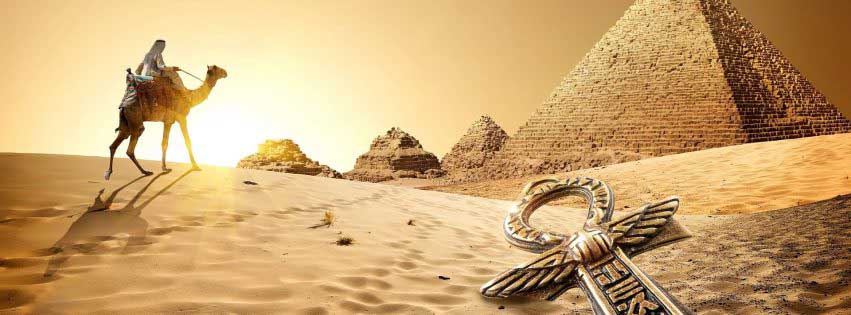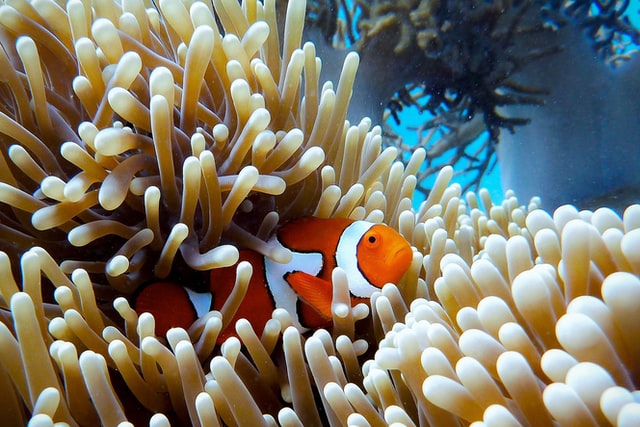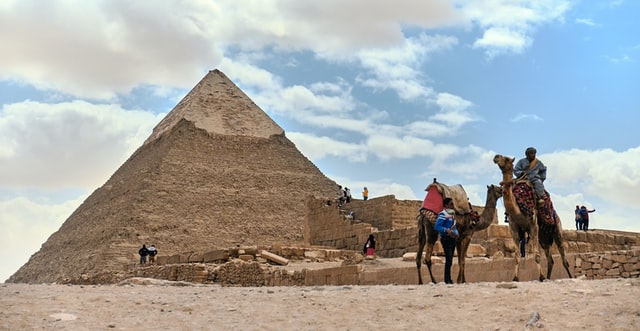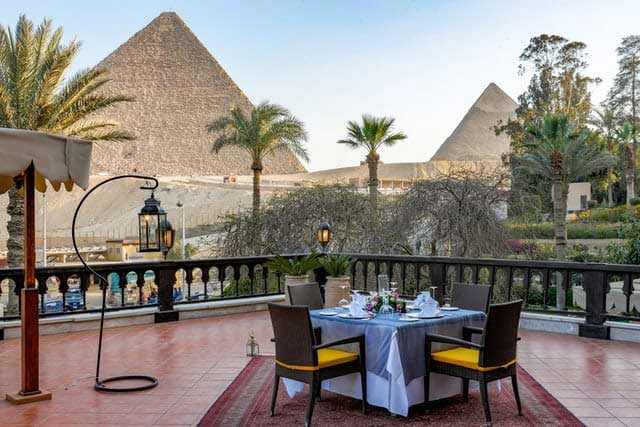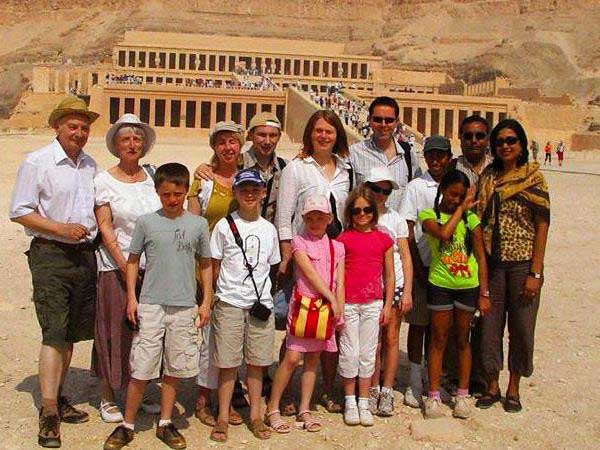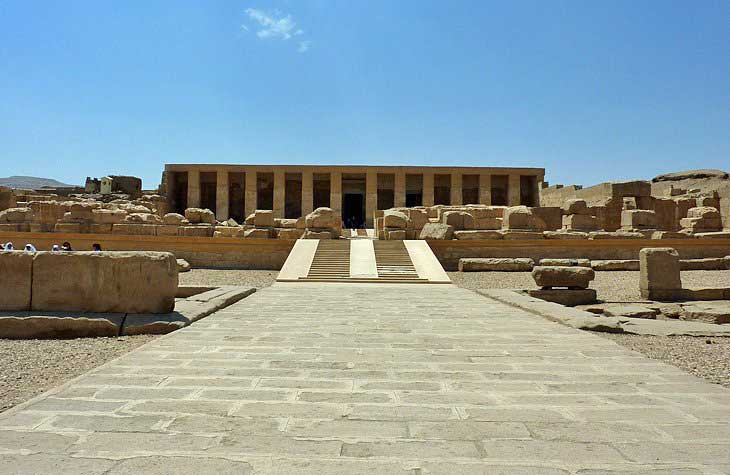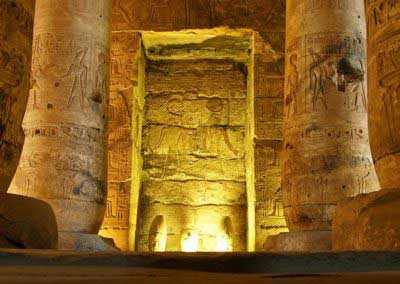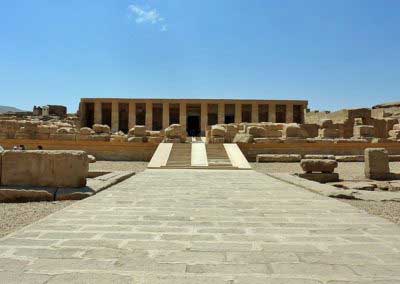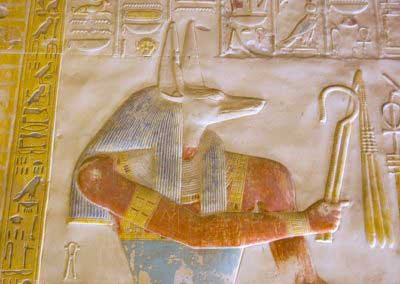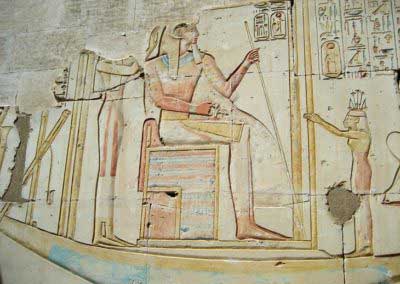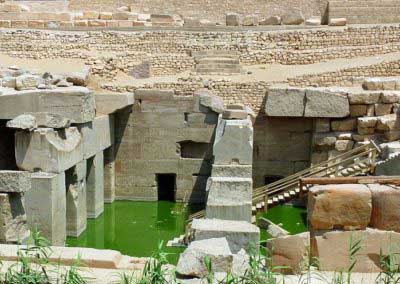Temple of Abydos
Abydos was Ancient Egypt’s most important burial center. Although the archaeology site here is vast, the main tourist attraction most people center their visit around is the beautiful Temple of Seti I.
Considered one of the most important archaeological sites in Egypt, the sacred city of Abydos was the site of many ancient temples, including Umm el-Qa’ab, a royal necropolis where early pharaohs were entombed. These tombs began to be seen as extremely significant burials and in later times it became desirable to be buried in the area, leading to the growth of the town’s importance as a cult site.
Today, Abydos is notable for the memorial temple of Seti I, which contains an inscription from the Nineteenth Dynasty known to the modern world as the Abydos King List. It is a chronological list showing cartouches of most dynastic pharaohs of Egypt from Menes until Seti I’s father, Ramesses I. It is also notable for the Abydos graffiti, ancient Phoenician and Aramaic graffiti found on the walls of the Temple of Seti I.
The Great Temple and most of the ancient town are buried under the modern buildings to the north of the Seti temple. Many of the original structures and the artifacts within them are considered irretrievable and lost; many may have been destroyed by the new construction.
This article contains information about The Temple of Abydos including:
Where is the Abydos temple located?
Abydos is 162 kilometers north of Luxor and can easily be visited as a day trip from the city of Luxor. The Temple Of Abydos or The Temple of Seti I is located in Abydos, the 8th province in ancient Egypt. The area is considered to be amongst the most famous archaeological sites in the wortld. In ancient times it was called Abdu, and the Greeks called it Abydos.
Abydos is home to many tombs belonging to the 1st and 2nd Dynasties. Also, many Kings built temples here, including King Pepi I, King Ahmose I, King Seti I and King Ramses II. Ancient Egyptians believed that the tomb of Osiris, the “God of the Dead, and the Underworld” was located in Abydos, and it is where his head was buried.
Visiting the Temple of Abydos
Abydos is much less visited than the temples of Luxor and the Nile temples of Edfu and Kom Ombo farther south, but for travelers interested in the Pharaonic era’s artistry, the vibrantly colored wall and ceiling paintings, as well as the sculpted column work of the Temple of Seti I, are a highlight of a Nile journey and shouldn’t be missed.

How much does it cost to visit the Temple of Seti at Abydos?
Tickets, which cost 100 Egyptian pounds (approximately $6) for adults and 50Egyptian pounds (or $3) for students, can be purchased at the entrance’s visitors center.
The history of Abydos
Most of Upper Egypt became unified under rulers from Abydos during the Naqada III period (3200–3000 BCE), at the expense of rival cities such as Hierakonpolis. The conflicts leading to the supremacy of Abydos may appear on numerous reliefs of the Naqada II period, such as the Gebel el-Arak Knife, or the frieze of Tomb 100 at Hierakonpolis.
Tombs and at least one temple of rulers of the Predynastic period have been found at Umm El Qa’ab including that of Narmer, dating to circa 3100 BCE. The temple and town continued to be rebuilt at intervals down to the times of the Thirtieth Dynasty, and the cemetery was in continuous use.
The pharaohs of the First Dynasty were buried in Abydos, including Narmer, who is regarded as the founder of the First Dynasty, and his successor, Aha. It was in this time period that the Abydos boats were constructed. Some pharaohs of the Second Dynasty were also buried in Abydos. The temple was renewed and enlarged by these pharaohs as well. Funerary enclosures, misinterpreted in modern times as great ‘forts’, were built on the desert behind the town by three kings of the Second Dynasty; the most complete is that of Khasekhemwy, the Shunet El Zebib.
From the Fifth Dynasty, the deity Khentiamentiu, foremost of the Westerners, came to be seen as a manifestation of the dead pharaoh in the underworld. Pepi I (Sixth Dynasty) constructed a funerary chapel which evolved over the years into the Great Temple of Osiris, the ruins of which still exist within the town enclosure. Abydos became the centre of the worship of the Isis and Osiris cult.
During the First Intermediate Period, the principal deity of the area, Khentiamentiu, began to be seen as an aspect of Osiris, and the deities gradually merged and came to be regarded as one. Khentiamentiu’s name became an epithet of Osiris. King Mentuhotep II was the first to build a royal chapel. In the Twelfth Dynasty a gigantic tomb was cut into the rock by Senusret III. Associated with this tomb was a cenotaph, a cult temple and a small town known as “Wah-Sut”, that was used by the workers for these structures. Next to the cenotaph at least two kings of the Thirteenth Dynasty were buried (in tombs S9 and S10) as well as some rulers of the Second Intermediate Period, such as Senebkay. An indigenous line of kings, the Abydos Dynasty, may have ruled the region from Abydos at the time.
New construction during the Eighteenth Dynasty began with a large chapel of Ahmose I. The Pyramid of Ahmose I was also constructed at Abydos—the only pyramid in the area; very little of it remains today.
Thutmose III built a far larger temple, about 130 ft × 200 ft (40 m × 61 m). He also made a processional way leading past the side of the temple to the cemetery beyond, featuring a great gateway of granite.
Seti I, during the Nineteenth Dynasty, founded a temple to the south of the town in honor of the ancestral pharaohs of the early dynasties; this was finished by Ramesses II, who also built a lesser temple of his own. Merneptah added the Osireion, just to the north of the temple of Seti.
Ahmose II in the Twenty-sixth Dynasty rebuilt the temple again, and placed in it a large monolith shrine of red granite, finely wrought. The foundations of the successive temples were comprised within approximately 18 ft (5.5 m). depth of the ruins discovered in modern times; these needed the closest examination to discriminate the various buildings, and were recorded by more than 4,000 measurements and 1,000 levellings.
The last building added was a new temple of Nectanebo I, built in the Thirtieth Dynasty. From the Ptolemaic times of the Greek occupancy of Egypt, that began three hundred years before the Roman occupancy that followed, the structures began to decay and no later works are known.
The layout and description of Abydos Necropolis site
Abydos was Ancient Egypt’s most important burial center. Although the archaeology site here is vast, the main tourist attraction most people center their visit around is the beautiful Temple of Seti I.
Temple of Seti I
The Temple of Seti I at Abydos is the main highlight of a trip here. Built of limestone and laid out on three levels, the temple is unusual in many respects from other Egyptian temples.
There are no fewer than seven sanctuaries in the inner temple here honoring Osiris, Isis, Horus, Ptah, Re-Harakhte, Amun, and the deified Pharaoh Seti I.
The front part of the temple is thus divided into seven individual temples, each with its own doorway, and the chambers behind the chapels are not arranged behind one another, as in other temples, but side by side.
First Courtyard
You enter the humongous temple complex from the northeast, through the First Pylon, now in ruins, which leads into the largely destroyed First Courtyard.
The First and Second Courtyard areas were built by Ramses II (Seti I’s son), so the relief decoration here celebrates his reign. On the courtyard’s southeast wall are scenes from Ramses II’s wars and victories in Asia, including the famed Battle of Qadesh (also portrayed at Ramses II’s Temples of Abu Simbel) against the Hittite armies.
Secound Courtyard
The First Courtyard leads you into the better preserved Second Courtyard. To the right and left, you can see dedicatory inscriptions in the name of Ramses II. On the far side of the court, a low ramp leads up to the temple proper and a Vestibule with 12 sturdy pillars.
Don’t Miss: On the wall to the left of the main doorway is an inscription in 95 vertical columns recording the completion of the temple by Ramses II. The reliefs depict Ramses in the presence of various deities.
Look up to the one scene adjoining the doorway, which shows him presenting an image of the goddess Maat to the triad of Osiris, Isis, and Seti I (here taking the place of Horus).
First Hypostyle Hall
The central doorway guides you into the temple’s massive First Hypostyle Hall, the partly destroyed roof of which is supported on 24 papyrus cluster columns with bud capitals. As with the courtyards, this hall was also completed by Ramses II.
Note how the columns are so arranged that the five central processional aisles leading to the chapels are flanked by two pairs of columns, while the two outermost aisles are bounded on one side by the walls of the hall.
Second Hypostyle Hall
Seven doors corresponding to the walled up entrance doorways, lead into the Second Hypostyle Hall, with 36 columns set in three rows supporting the architraves and the roofing slabs, which rest on them.
This is by far the most atmospheric section of the temple and the finely detailed reliefs decorating the walls, all dating from the reign of Seti I, rank among the finest achievements of Egyptian sculpture. The hall was the final part of the temple built by Seti I.
The arrangement of the columns flanking the processional aisles is similar to that in the preceding hall.
The 24 columns in the first two rows have closed papyrus capitals. The columns in the third row, set on a raised platform, are tree trunk columns with cylindrical shafts and no capitals, on which rest stone slabs forming an abacus for the support of the architrave.
The Osireion
Southwest of the Temple of Seti I, you find the large structure known as the Osireion.
Often mistaken by visitors for the Tomb of Osiris, it is, in reality, a cenotaph of Seti I, closely associated with the main temple.
It was discovered in 1903 by Margaret A. Murray and excavated between 1911 and 1926 by the Egypt Exploration Society under the direction of E Naville and Dr. Frankfort.
The building, originally covered by an artificial mound and surrounded by trees, was erected by Seti I, but remained unfinished.
Later, some rooms were decorated with religious scenes and inscriptions by Merneptah. The main structure is built of white limestone and reddish sandstone, red granite being used only for the pillars and roof of the main hall and some of the doorways.
It’s unfortunately closed to the public. Head to the back of the Temple of Seti I to get a decent overall view of the building.
Temple of Ramses II
A short distance away are the remnants of the once grand Temple of Ramses II, also dedicated to Osiris and the cult of the dead pharaoh.
In front of the present entrance was a large court of which only a few traces remain.
The masonry of the temple itself is preserved only to a height of two meters, but it is still possible to trace the outlines of a court surrounded by colonnades with pillars and Osiris figures, similar to those in Luxor’s Ramesseum.
It was constructed of fine-grained limestone, with red and black granite for the doorways, sandstone for the columns, and alabaster for the innermost sanctuary.
The mural decorations are in delicate low relief with some of the best preserved paintings in the first court depicting a sacrificial procession.
The reliefs on the outside of the temple (north and west sides), worked in fine white limestone, are among the finest produced in the reign of Ramses II and depict scenes from the pharaoh’s war against the Hittites
Recommended Tours to the Temple of Abydos:
Frequently asked questions about visiting Egypt
Is it safe to travel to Egypt
Is it safe to travel to Egypt?
Is Egypt Safe for Americans to Travel to
Is Egypt Safe for Americans to Travel to?
We get this question a lot at Bastet Travel In short, Americans and other visitors can rest easy: yes, Egypt is a safe country for tourists. And the rest of the world seems to agree — after years of middling numbers, tourism in Egypt is steadily rising towards its former highs, hosting over 9 million sightseers in 2018. The longer answer is worth exploring, though, and we have some assurances to offer all our clients who join us on all of our Egypt Travel Packages.Is a negative COVID-19 test (PCR and/or serology) required for entry?
- Yes.
- All passengers travelling to Egypt (including Egyptians) must be in possession of negative PCR test certificate for COVID-19, taken at a maximum of 72 hours before their flight departure time.
- Passengers travelling from Japan, China, Thailand, North America, South America, Canada, London Heathrow, Paris, and Frankfurt will be allowed to provide the test certificate performed at a maximum of 96 hours prior to flight departure, due to the long travel and transit period from these airports.
- Although we understand the PCR testing policy to require a test result performed no more than 96 hours before the original departing flight, we have received anecdotal reports that some travelers have been denied entry when their PCR test was performed more than 96 hours prior to the departure of their connecting flight.
- Travelers must present paper copies of the test results; digital copies will not be accepted.
- Children under the age of six of all nationalities are exempt.
Are PCR and/or antigen tests available for US citizens in Egypt?
Yes, at numerous private testing centers, as well as the Central Public Health Lab.
Has the government of Egypt approved a COVID-19 vaccine for use?
Yes
Which vaccines are available in Egypt?
AstraZeneca and Sinopharm.
Are vaccines available in Egypt for tourists to receive?
Yes, the media has reported that anyone over age 18, including foreign residents, can now register for the vaccine. There is limited supply of the vaccine available and the media reports that priority for the vaccine will go to the elderly and those with chronic illnesses.
Are test results reliably available within 72 hours?
Yes. Most test providers offer 48-hour turnaround. Faster service is possible at extra cost.
How can I obtain my Visa to visit Egypt?
How can I obtain my visa to visit Egypt?
What do i need to know when traveling to Egypt?
A few Things to Know Before Traveling to Egypt
You need a visa, and you can buy it upon arrival. The dollar goes far in Egypt. The traffic in Cairo/Giza is outrageous, but taxis (and Ubers) are cheap. You should not skip the Pyramids and Sphinx. The Pyramids and Sphinx are just the beginning of the ancient treasures. Islamic Cairo is amazing. Aswan should not be missed The Sahara is more than sand It is safer than you thinkWhat are the best day trips in Egypt
What are the most famous tourist attractions in Egypt
What are the most famous tourist attractions in Egypt?
Egypt has so much for travelers to see and do, it’s the perfect country for a mix of activities combining culture, adventure, and relaxation. Find the best places to visit with our list of the top tourist attractions in Egypt.- Pyramids of Giza
- Valley of the kings
- Luxor’s Karnak Temple
- The Egyptian Museum
- Christian and Islamic Cairo
- The White Desert and Baharyia Oasis
- Siwa Oasis
- Abu simbel Temples
- Aswan
- Alexandria
- St. Catherine’s Monastery
- The Nubian village
- Nile River Cruise
- Hurghada
- South of Sinai
Related Articles
Related
Seth
Also known as Set, Setekh, Suty and Sutekh, Seth was the god of chaos, darkness, violence, evil, deserts, storms, and one of the Osirian gods. In the Osiris myth, he is the murderer of Osiris (in some versions of the myth, he tricks Osiris into laying down in a coffin and then seals it shut.)
Ancient Egyptian Gods And Goddesses
For all ancient Egyptians, the world was filled with mystery. Much of what they experienced in the world around them was unknowable and frightening. The ancient Egyptian gods and goddesses represented aspects of the Egyptians’ natural and “supernatural” surroundings and helped them understand its many aspects.
Horus
Depicted as a falcon or as a man with a falcon’s head, Horus was a sky god associated with war and hunting. He was also the embodiment of the divine kingship, and in some eras the reigning king was considered to be a manifestation of Horus.



